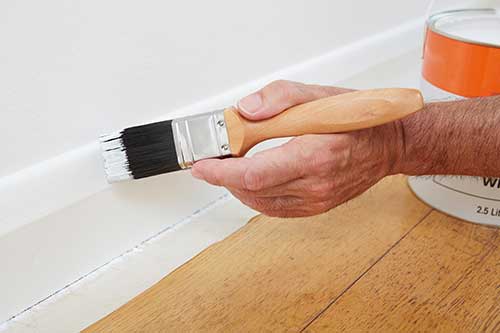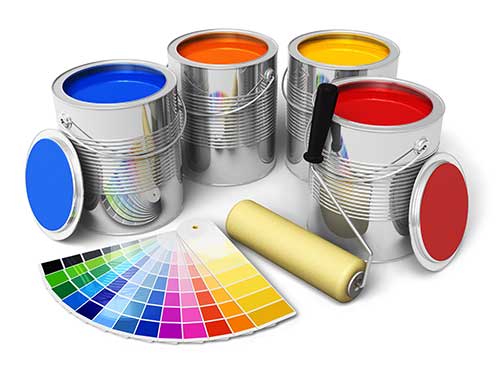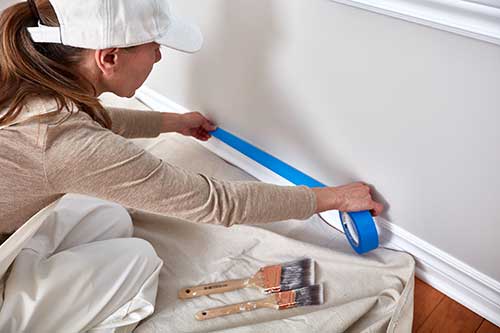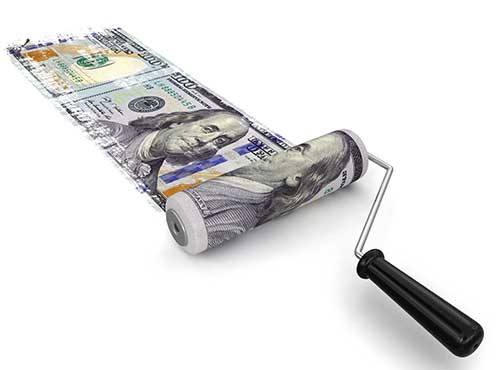Painting Baseboards
 Baseboards are always an afterthought and overlooked most of the time. But the truth is they play a big role in protecting the walls.
Baseboards are always an afterthought and overlooked most of the time. But the truth is they play a big role in protecting the walls.
Trim and baseboards add to the architectural interest of any room, especially if you are planning to sell it. Fresh coats of paint make the features stand out even more.
Like many other home improvement jobs, painting baseboards isn’t that difficult. Our article takes you through the process of priming and painting the trim, the materials needed, the cost, and everything in between.
What Is the Fastest Way to Paint Baseboards?
Painting baseboards is one of the simplest tasks, even for a beginner. Here’s how you complete the daunting task effortlessly.
- Clean to remove dust and lightly sand the baseboard.
- Tape the top closer to the wall with painter’s tape. Press along the edges to make sure it adheres properly.
- Hold a piece of cardboard along the edge of the baseboard right where it meets the floor.
- Prime the surface with a primer and let it dry.
- After priming, paint the wood. You will need two coats of paint for a uniform finish.
- Let the first coat dry before going ahead with the second coat.
Do You Paint Walls or Trim First?
Paint the trims before you start on the walls. That way, you can move fast without worrying about the mess.
Once the trim is complete, let it dry for at least 24 hours. Use an easy release painter’s tape to mask the painted trim and then continue with the walls.
Can You Use a Roller to Paint Baseboards?
Yes! You can use paint rollers to paint baseboards. A smooth-medium, 3-inch roller should work well.
Ensure that your roller is lump-free and consistent when touched. Also, remove lint with tape before using the roller.
Can You Paint Baseboards With a Sprayer?
Yes! A high-volume, low-pressure spray works the best for small areas like trim and baseboard. The choice of nozzle depends on the paint.
A compressed air sprayer is another great option. It sprays very fine layers of paint, leaving behind a sleek and uniform look. However, considering the price, you may not want to shell out so much for a one-time job.
How Long Does It Take to Paint Baseboards?
Painting your baseboards is a pretty easy job. It only takes you about a day or two to paint your baseboards, complete with all the prep.
After priming, it should take you just 30 minutes to an hour for one coat.
How Do You Prepare Baseboards for Painting?
Prepping the baseboards takes the most time and effort. But, it pays off when you have a glossy coat of paint on your baseboard.
Here are a few tips to prepare your baseboard for painting.
- Wipe your baseboards with a rag cloth.
- Patch the holes and dents with a painter’s tool.
- Buff them down for a smooth surface with sandpaper.
- Apply a coat or two of primer to help the paint adhere.
Do I Need to Sand Baseboards Before Painting?
Yes! You need to sand your baseboards first. This way, you start with a clear surface without any imperfections.
- First, use coarse, 80-grit sandpaper and then move on to either 100 or 120 grit.
- If the wood is new, a 120-grit sandpaper is enough.
- After sanding, wipe away the dust using a damp sponge.
Use a sanding block for flat surfaces and a sanding sponge for curved areas.
 What Kind of Paint Do You Use on Baseboards?
What Kind of Paint Do You Use on Baseboards?
When it comes to paints for baseboards, they may be:
- Water-based/latex paint
- Oil-based
- Acrylic-Alkyd Hybrid
Oil-based paint contains VOCs and is harmful to the environment. Hence, water-based or acrylic-alkyd hybrid paints seem to be the choice of many homeowners.
What is the Best Paint Finish for Baseboards?
The finish is purely a personal preference.
If you prefer a matte and rich look, eggshell should be your choice. It is durable, easy to clean, and also more forgiving.
On the other hand, if you are looking for luster, go for semi-gloss. It has maximum durability and handles wear and tear better than other finishes making it a choice of professionals.
What Is the Best White Paint Color for Baseboards?
White baseboards always make your room look stylish and modern. Not just that, it also gives you the flexibility to change the color later on.
Though white paints may look the same, every white has a different undertone. So, you may want to compare a few whites before purchase.
The best whites currently in the market are:
- Highly Reflective White SW from Sherwin Williams
- Extra White SW7007 from Sherwin Williams
- Super White OC-152 from Benjamin Moore
- Decorator’s White OC-20 from Benjamin Moore
Can You Paint Trim with Chalk Paint?
Surprisingly Yes! You can paint your trim with chalk paint. They go on even and require much less product than usual. Their drying time is also much less when compared to other paints.
And you do not need to prep work or apply a primer; Just clean and get painting.
Since chalk paint is matte, you need to seal the look with Clear Soft Wax.
Chalk Paint® by Annie Sloan seems to be the choice of homeowners looking for chalk paint trims.
Do I Have to Sand Before Painting with Chalk Paint?
No! Generally, there is no need for sanding when it comes to chalk paint. Chalk adheres to wood without any sanding or priming.
But, you’d want to clean the surface before painting. Grease stains are easily visible through chalk.
What Is the Best Brush for Painting Trim?
When painting baseboards, it is important to use the right brush for a more precise look. Brushes are versatile and hold more paint; Hence, they can create a variety of finishes.
For trims and baseboards, a small angle sash brush measuring 1″ – 2 1/2″ works the best. They maneuver easily in tight spaces and offers stability.
The top picks are:
- Purdy 144080515 XL Elite Dale Sash Paint Brush
- Wooster 2-inch Shortcut Polyester Angle Sash Brush
How Do You Paint Baseboards without Brush Marks?
With a little care and precise application, you should be able to avoid brush marks and streaks while painting your baseboard.
- Dip only the tips of the paint brush, about 1″. Instead of wiping it down, slap on the inside of the pail. This removes the excess while still keeping the brush loaded.
- Immediately apply paint with a few back-and-forth strokes. Then drag the tips across the same space in one stroke without reloading again.
- Avoid too many brush strokes.
How Often Should You Paint Baseboards?
Your baseboards bear the brunt of wear and tear with the scuff marks, toys, etc. It helps to paint your baseboards every two to three years to maintain a pristine appearance.
Ensure you also clean the baseboards now and then to prevent the accumulation of dirt and grime.
 How Do You Paint Baseboards without Getting Paint on the Carpet?
How Do You Paint Baseboards without Getting Paint on the Carpet?
With a carpet, you run the risk of paint dripping down, creating a mess in the process. If the brush picks up lint, it may get dragged leaving behind unsightly marks.
Here’s how you prevent the paint from getting on the baseboards:
- Apply a 2-3″ painter’s tape on the floor along the edge of the baseboard. Double-check that the carpet is not visible.
- Use a long piece of tape to prevent seams where the paint could seep through.
- Use a putty knife to push the edge under the baseboard.
- Paint as usual but avoid heavy drips or rundowns.
- Remove the tape before the paint is dry.
How Do You Paint Baseboards without Getting Paint on the Wall?
Unless you are a pro, you are sure to get some paint on the walls. A masking tape applied to the wall adjacent to the baseboards works beautifully to contain the mess.
What Do I Use to Fill Gaps in Baseboards?
You can fill the gaps in the baseboard and trim using caulk. It creates an airtight seal along the seams.
But, the downside is that they can shrink and hence cannot be used for nail holes.
Should You Caulk baseboards Before or After Painting?
You need to caulk the baseboards before painting. Most caulks can discolor after some time and need a coat of paint.
However, if it is new wood, you need to apply a coat of primer before you caulk. Caulk tends to come off otherwise.
 How Much Does it Cost to Hire Someone to Paint Trim?
How Much Does it Cost to Hire Someone to Paint Trim?
The cost to paint trim is approximately $500-$1500 for a 1500 sq ft home. Most professionals charge $25-$75 every hour of labor.
On the other hand, baseboard costs $1 – $5 for every linear foot of your home.
The charges include paint, labor, and supplies.
Is It Cheaper to Paint Baseboards or Replace Them?
If your baseboards show regular wear and tear, painting can help brighten them. Though the painting shouldn’t take time, the prep work is intensive and time-consuming.
Replacing the baseboards, on the other hand, can be expensive. Hence, replace it only in the case of water damage or warped boards.
How Much Does It Cost to Paint Trim Yourself?
The supplies can easily cost around $250 – $600. If you have the time and the patience, it helps to paint the trim yourself.
You’ll need at least a weekend to get everything done.
How do You Paint Electric Baseboard Heaters?
Painting your baseboard heaters is the same as your regular baseboards, except for the change in products:
- Clean your baseboard with steel wool to get them ready for primer.
- Apply 2 coats of primer and let dry.
- Lay a drop cloth down to catch the drips
- After priming, apply two coats of paint.
Do You Need Special Paint for Baseboard Heaters?
You can use any regular paint for baseboard heaters. The heat should not affect the integrity even if cranked high. But ensure that you have your primer first.
Experts suggest latex paint or alkyd paint.
Conclusion
Painting baseboards can improve the look of your room drastically. But, it needs regular maintenance and a paint job every few years to maintain the up look.
Though installing is a job for the professionals, you can do the painting yourselves.
White paint is currently ‘IN’, with Annie Sullivan’s chalk paint taking the crown. Semi-gloss and eggshell also remain the favorite of the professionals.
Also, always ensure that the wood is primed before commencing the painting. A painters tape applied along the edge of the wall, and the floor should help you catch drips.
Don’t want to do it yourself? Get a professional to do it for you.
Categories
- Church Painting (1)
- Commercial Painting (19)
- Exterior Painting (9)
- Interior Painting (3)
- FAQ (1)
- Floor Coating & Sealing (6)
- General (14)
- Industrial Painting (1)
- Metal Painting (1)
- Paint Prep (3)
- Painting Contractors (5)
- Pool Deck Epoxy (1)
- Residential Painting (33)
- Baseboards & Trim (2)
- Cost (3)
- Exterior Painting (8)
- Interior Painting (7)
- Tips (2)
- Walls (6)
- Roof Replacement (1)